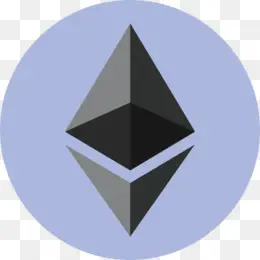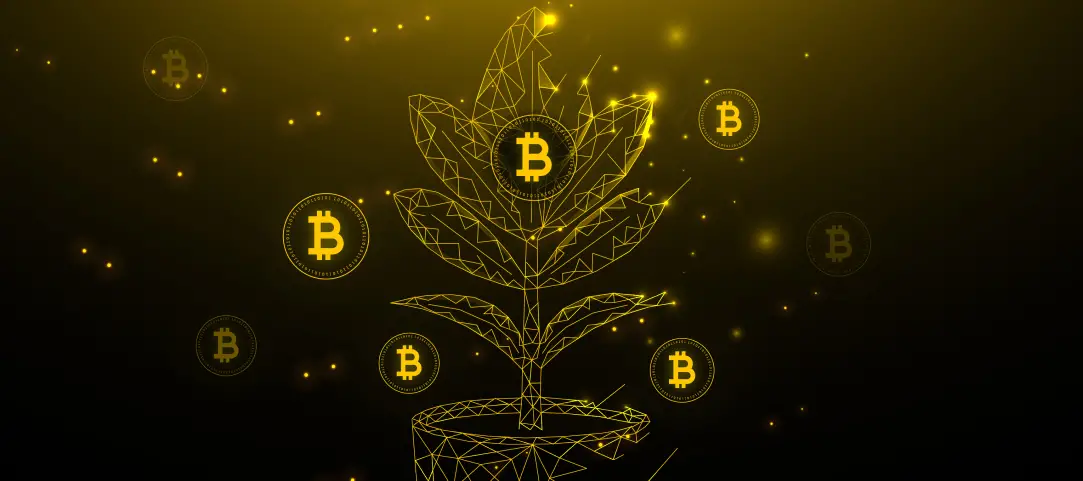Table of Contents
Lending, staking and liquidity providing are the basic DeFi activities. In our previous article, we discussed crypto launchpads. Today, we will go deeper into what is yield farming.
Yield Farming is the process of maximizing the gains.
What is Yield Farming
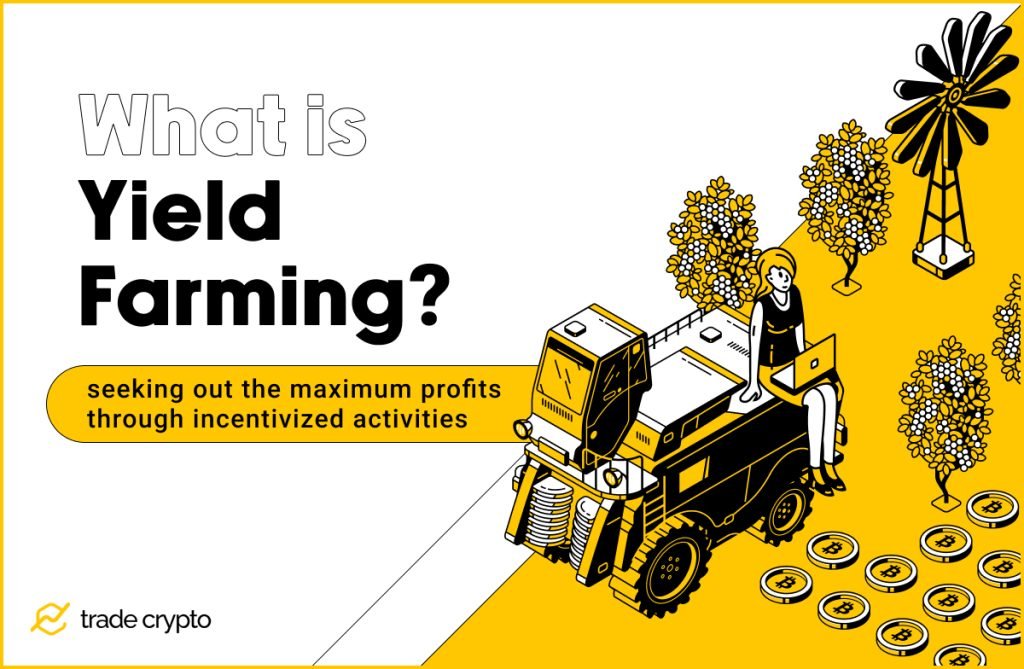
Crypto Yield Farming can be a confusing term. How does it differ from lending crypto or providing liquidity? You will often see platforms promoting high APRs or APYs, what are those? In this article, we will explain what’s yield farming, how does yield farming work, and present some of the best DeFi yield platforms.
The DeFi sector is growing. The total locked value (TVL) in DeFi is close to $77 billion. This is the estimated sum of all the crypto invested in various DeFi projects. More importantly, this part of the crypto industry saw 47% growth in just a year. Compared to traditional financial sectors, there is still vast space for DeFi to grow, which makes DeFi very interesting for investors.
Through different platforms and Decentralized Exchanges (DEX) users can lend out their crypto, borrow against their crypto, stake it or provide liquidity. To further incentivize investors, many DEXes offer different ways for users to earn additional income in form of platform tokens.
For example, TraderJoeXYZ rewards investors with both additional Avalanche (AVAX) coins, as well as the platform-native tokens (JOE) if they participate in incentivized activities. This practice means that an investor will collect regular income according to their activity, plus the additional tokens, and the practice of seeking out the maximum profits is called – yield farming strategies.
Types of Yield Farming
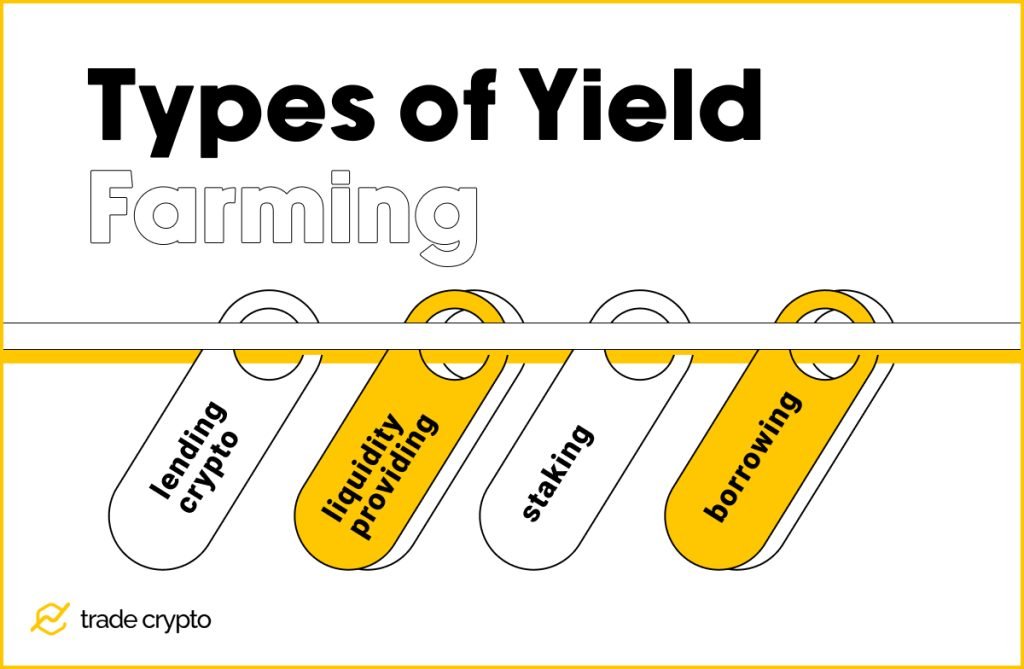
There are different ways to yield farms, and new methods are being offered as DeFi space matures. Often, the process involves different types of earning crypto combined, for that maximum yield, hence the name.
Lending crypto is currently the simplest method of earning. Many platforms started offering only the lending service or crypto savings account, where the yield actually comes from lending. Nowadays, almost every DEX provides this option.
Token holders deposit their assets to DEX. Smart contract handles transactions to borrowers, and the investor earns a portion of the interest paid on the loan. However, many exchanges will incentivize users to provide coins for lending, rewarding them with additional tokens.
Liquidity providing is the lifeblood of DeFi. Because decentralized exchange doesn’t operate like a bank, they don’t own coins to offer, nor do they work with order books like traditional exchange would, keeping tabs on orders and matching buyers and sellers.
Instead, they rely on investors to provide trading pairs of assets. Deposited in a pool, smart contracts called Automated Market Makers then automatically balance the exchange price according to supply and demand, while the investor earns a portion of the exchange fee.
The yield farming strategy grows from there. DEX can offer a liquidity provider (LP) token that either has intrinsic market value or can be staked for further yield as an incentive for investors to keep the assets in the pool. Alternatively, native platform tokens can be issued to an investor. Commonly, the rewards are spread, eg. the user would gain an LP token, some native tokens, as well as a portion of exchange fees.
Staking is the most common yield strategy offered by modern DEXes. User can pledge their tokens to proof-of-stake networks to provide security. They are rewarded by interest paid in the network’s native token. Additionally, many DEXes will provide LP tokens to investors, and offer those same LP tokens to be staked for even more yield.
Borrowing can be a good strategy for farmers who can borrow against the deposited collateralized asset to further invest, stake, or provide liquidity. That way they earn interest on the deposited tokens, as well on the borrowed assets for maximum yield.
How to start Yield Farming?
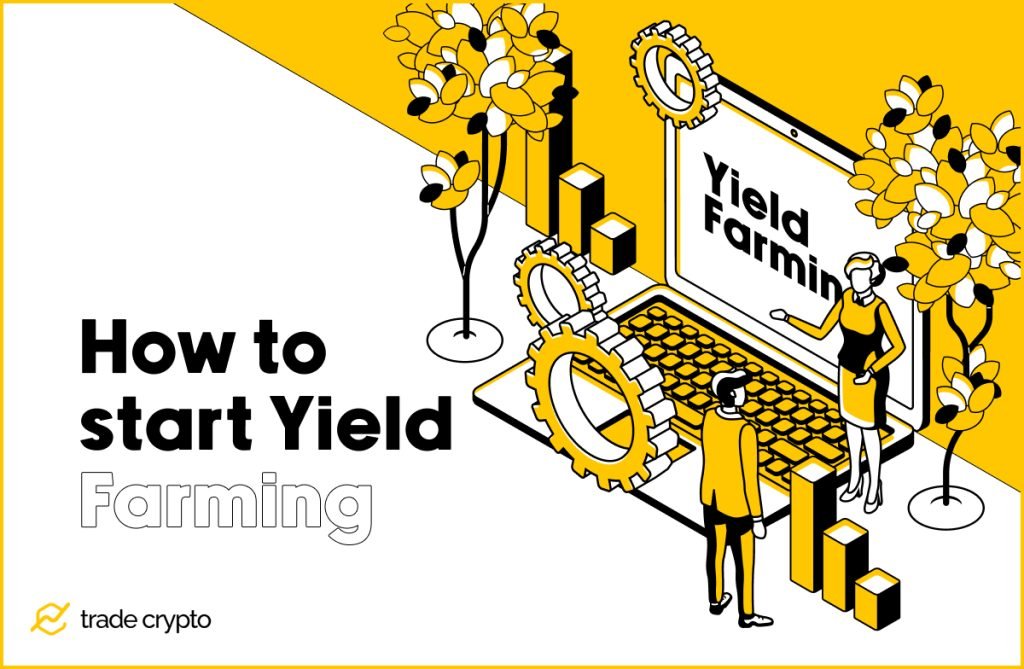
First of all, do your own research. DeFi space is moving fast. Liquidity pools can be closed by an exchange, they can also change ARP or APY, so an investor needs to keep track of these changes to avoid loss and keep maximizing the yield.
APR and APY are not really the best metrics, but until DeFi comes out with something more suitable, they are a good indicator of how profitable (and often, how risky) your farming strategy is.
Namely, the standard on farming platforms is to present yield in Annualized Percentage Yield (APY). It is a rate of return from an investment, expressed in annual yield, which takes in account compound interest (interest earned on that interest).
You need to find it in the DeFi platform’s documentation how they calculate compounding periods. In the traditional finances compounding is done monthly or quarterly, but in DeFi daily compounding is becoming a standard.
Next, you have to watch out for coin inflation as well as supply/demand fluctuations and overall crypto volatility. That’s why you will find three-figure APY promised for very young or very volatile tokens, while established assets with great supply can typically yield around 5% APY.
It’s still better than traditional banking which offers interests rarely exceeding 1% APY. Generally, if you want to invest in an established token, 12-20% APY is considered good. Everything above it usually indicates an increased risk.
Once you have done your research, the steps are fairly simple:
Step 1
Decide what is your strategy and which platform you want to use.
Step 2
Create a crypto wallet that will hold your preferred tokens. While many wallets support a nice range of tokens, do check if it will hold yours. Make sure that your wallet is connected to the right network.
E.g. if you want to trade with TraderJoeXYZ, Metamask set to Avalanche network will do just fine. But if you want to connect with Compound, you will need to set your wallet to the Ethereum network.
Step 3
Have some funds in your wallet. Transfer funds from an existing wallet or existing account at a crypto exchange. The starting point is often Coinbase or Binance as the easiest platform to get the initial assets. Use swap platforms to obtain the coins you need.
Often, you can’t buy the tokens that yield the most with a credit card or bank order. You may need to get a stablecoin (USDT, USDC) and then use Uniswap or another exchange platform to get the more exotic tokens you want to yield farm.
Step 4
Deposit the tokens from your wallet to your preferred DeFi platform. According to your strategy, you can deposit them in Liquidity Pool, or just offer them for lending. Make sure to learn how the LP tokens or additional crypto are rewarded. You might need to stake or apply to a yield farm staking, depending on the platform.
This usually involves two steps. First, you make sure to have two types of tokens. Then you deposit an equal value of tokens in the liquidity pool. The next step is to mint an LP token. And finally, you stake LP token at the yield farm of your preferred DEX.
Step 5
Wait for your profits to accrue. Daily yield is usually very small, so you will lose more in gas fees (tax for conducting transfers on the network) if you collect it more often. Once you are happy with your yield, transfer tokens to your wallet.
Enjoy your profits!
Platform list for yield farming
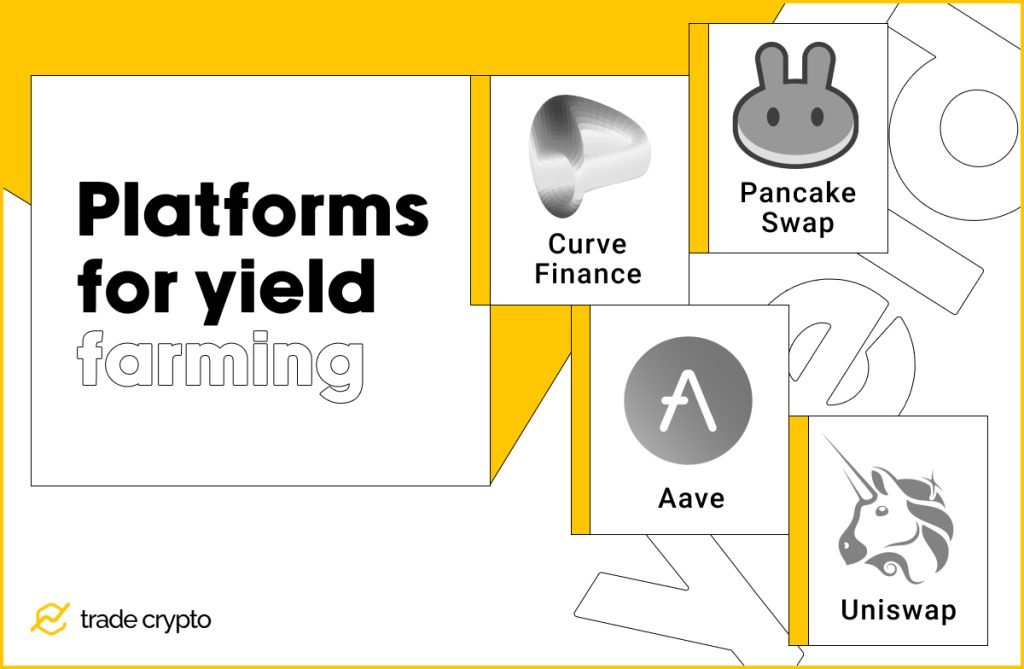
The following platforms are the best crypto yield farming you can find. Not only because they are tried and tested, but because they offer the best yield farming opportunities, with vast number of different tokens for investors of all sorts. Whether you want to go safe or play the high stakes game, you will find your spot in these platforms.
Curve Finance
While this is not your starting point, Curve is an amazing platform designed for low slippage (losses that come with swapping tokens), specialized for efficient stablecoin trading and low risk. Their UI is not for the faint of heart, hence they aren’t really the best for absolute beginners.
Their strongest point is that they allow the creation of liquidity pools, so investors can earn from token swap fees, plus the additional yield that protocol automates by connecting the pool with Compound and yield finance platforms.
Aave
This platform is specialized in lending and borrowing. This makes them safe to use above all. Investors can deposit assets to be lent out, or borrow against the deposited coins. It works on Ethereum Mainnet, so you might need to bridge your assets, e.g. wrap the tokens native to other platforms.
Yield is quite good, as you can collect not only the interest APY but also incentivized APY. For example, if you deposit AVAX (it will need to be wrapped, eg. WAVAX) you can get 2.4% APY for the deposited tokens, plus the 5.8% APY in additional yield.
Uniswap
Uniswap is a platform dedicated to exchanging, e.g swapping tokens. Of course, it relies on investors who provide assets and create their own markets to collect trading fees, much like Curve does.
The major advantage of Uniswap’s liquidity providing is that it allows investors to set their own price positions. This prevents losses, as users can set strict limits thus mitigating the volatility and an impermanent loss.
PancakeSwap
Not interested in ERC-20 tokens only? Do you prefer to conduct your crypto business within the Binance Smart Chain ecosystem? This is the platform for you! An additional benefit to novice investors it the robust and easy to use UI.
Providing liquidity earns LP tokens, which yield native CAKE tokens, that can be further staked for very high yields.
Risks of Yield Farming
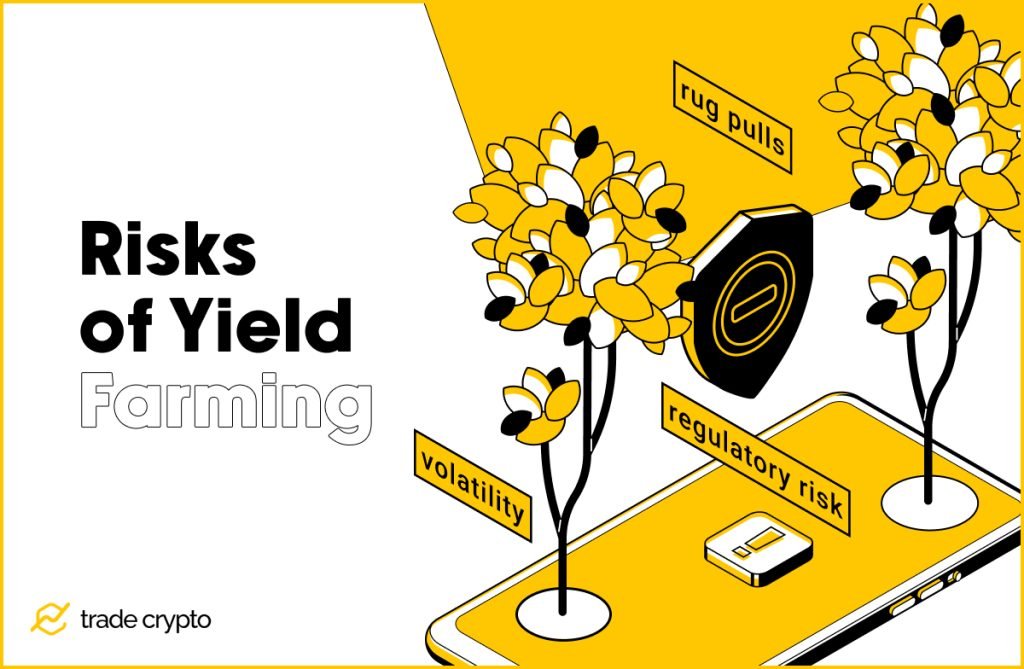
Yield farming is obviously a very lucrative way to reap the benefits of DeFi. It is considered safer than staking or any other investment, as there are security protocols and incentives that protect the investors.
However, there are some inherent risks connected with DeFi in general which translate to yield farming as well. Broadly we can categorize them into risks of scam and risks of volatility. Also mind the networks, as you will need to calculate gas fees in your investment plans.
Rug Pulls
This is a type of exit scam. It means that once you deposit your assets, they are essentially in the hands of the developers. That’s why you should always look for safe, audited protocols and platforms to invest with.
However, rug pulls can be performed by developers blocking the sale of their token, getting away with the provided liquidity, so carefully decide what projects (and their tokens) to support with yield farming.
Regulatory risk
While DeFi is by its nature separated from central authorities, regulatory bodies and enforcement agencies, it doesn’t mean that your crypto assets are safe from their decisions.
Cryptocurrencies are not yet regulated in a stable manner. Tokens you hold could be subject to change in regulations, as many governments aim to classify crypto assets as securities. DeFi platforms are still out of the reach of regulatory bodies, but you should watch out for how the regulators are operating, lest you be subject to hefty taxes or even penalties.
Volatility
The Crypto industry is still very young, nascent even. As recent events have shown, cryptocurrencies are not immune to outside factors. Regulatory bodies’ decisions, traditional market crashes, recessions, and even wars, all influence otherwise volatile crypto markets.
The Crypto landscape changes quickly as new solutions and new projects devalue the old, switching supply and demand abruptly. If you are a beginner in the world of DeFi, it might be a good idea to stick to stablecoins, as their value is fixed, pegged to a fiat currency (usually the USD).
Conclusion
Yield Farming is a step in the evolution of DeFi. It will continue to grow and change. Incentives for investors in form of yield farming provided much-needed liquidity to the DeFi. Many projects were funded thanks to additional token yields.
Yield farming also incentivized developers to work on interconnectivity and interoperability of networks and apps. This in the future will create an even larger community of investors and open new opportunities.
The room to grow is primarily in the tighter connection between various platforms, as well as in increasing the technology and security it can provide. Hence the great growth rate, and the chance for you to join the world of DeFi and start earning those juicy yields!
Crypto Ping Pong Digest
Trash style news. You will definitely like







